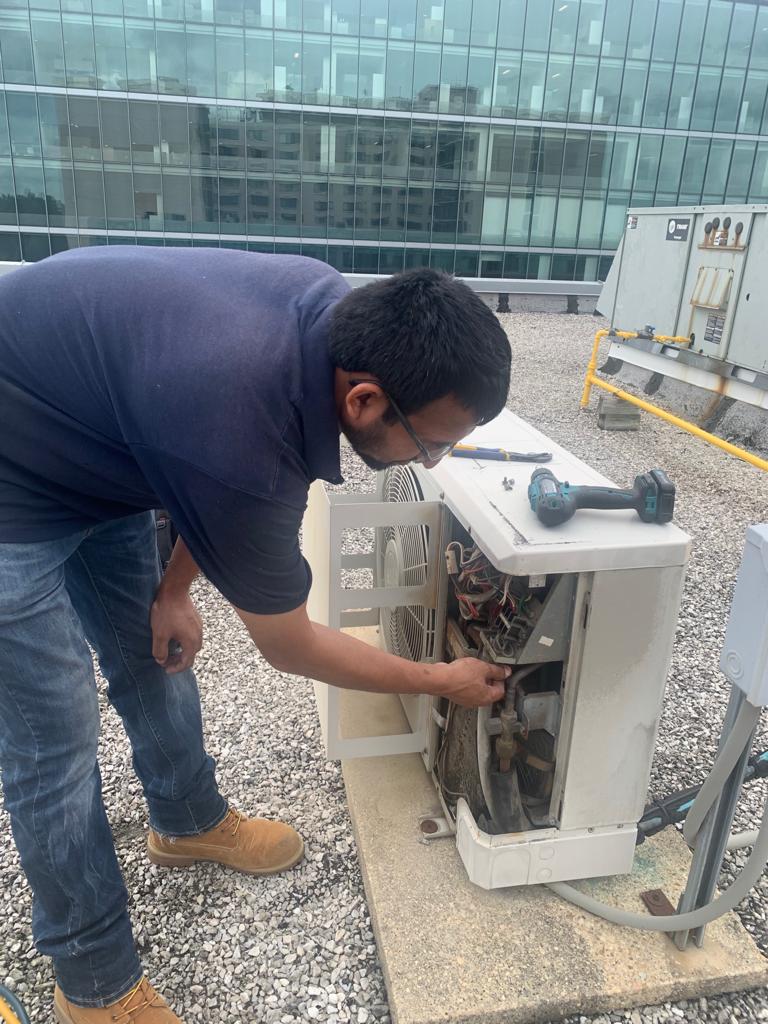
When it comes to keeping your home comfortable year-round, mini-split air conditioning service has become one of the most efficient and flexible options available. But many homeowners still face one big question:
Should you choose a ductless or ducted mini-split system?
Both systems use the same core technology, an outdoor condenser and one or more indoor air-handling units, but how they deliver cooled (and sometimes heated) air throughout your home can make a big difference in comfort, appearance, and efficiency.
Let’s explore the key differences between ductless and ducted mini-split AC systems, and help you decide which is right for your home in Centreville or the surrounding Northern Virginia area.
What Is a Ductless Mini-Split System?
A ductless mini-split system (also called a “wall-mounted” or “multi-zone” system) uses individual indoor units installed directly inside the rooms you want to cool or heat. Each indoor unit connects to the outdoor compressor via a small conduit that contains refrigerant lines, power, and drainage tubing no large ductwork required.
Advantages of Ductless Systems
- Energy Efficiency: Because there are no ducts, you avoid the typical 20–30% energy loss that can occur through leaky ductwork.
- Zoned Comfort: Each unit can be controlled independently, allowing different temperatures in different rooms.
- Easy Installation: Great for older homes without ducts, new additions, or converted spaces like garages or attics.
- Improved Indoor Air Quality: No dusty ducts mean cleaner, healthier air.
Disadvantages
- Aesthetic Impact: The indoor units are visible on walls or ceilings, which some homeowners may find less appealing.
- Higher Upfront Cost per Room: While efficient, installing multiple indoor units can increase the total price compared to a single central system.
What Is a Ducted Mini-Split System?
A ducted mini-split system (also called a “concealed duct” system) uses short runs of ductwork to distribute air from a hidden indoor air handler. The system still operates without the bulky duct network of a traditional central AC, but it offers a more discreet look.
Advantages of Ducted Systems
- Seamless Appearance: The air handler is hidden in an attic, ceiling, or crawl space, with only small vents visible in rooms.
- Even Air Distribution: Ducted mini-splits provide more balanced airflow and temperature consistency across multiple spaces.
- Quiet Operation: With the air handler tucked away, operation is nearly silent inside living areas.
Disadvantages
- More Complex Installation: Some ductwork is still required, which may not be ideal for homes without space to accommodate it.
- Potential Efficiency Loss: While smaller than full-size ducts, even short runs can introduce minor energy losses if not sealed properly.
Key Factors to Consider When Choosing Between Ductless and Ducted
1. Home Layout
If your home doesn’t already have ductwork, a ductless mini-split will save you from the cost and hassle of installing new ducts.
If your home has existing ductwork in good condition, a ducted system can use or replace those channels for a cleaner look.
2. Room-by-Room Comfort
Ductless systems are perfect for homeowners who want zoned control for example, keeping the bedroom cooler while saving energy in unused rooms.
Ducted systems are better suited for open layouts or when you want even temperatures throughout the entire home.
3. Energy Efficiency
Both systems are highly efficient, especially with inverter compressor technology. However, ductless systems typically win in efficiency because they completely eliminate duct losses. If your goal is to reduce monthly energy bills, ductless might be the smarter choice.
4. Aesthetics and Space
Some homeowners prefer the clean look of vents from a ducted mini-split, while others appreciate the modern style and flexibility of ductless wall units.
If space is limited or you’re renovating just one area, a ductless setup is often more practical.
5. Budget and Installation
While ductless systems can have a higher upfront cost per zone, they’re cheaper to install overall when no ducts exist.
Ducted systems may cost more to install initially if you need to modify ceilings or attics but can serve multiple rooms with a single concealed unit.
Maintenance and Longevity
Both systems require regular maintenance to stay efficient and reliable.
- Ductless units need filters cleaned every few weeks and professional servicing at least once a year.
- Ducted mini-splits should have ducts checked for blockages or leaks and filters replaced routinely.
If you ever notice inconsistent cooling, strange noises, or higher energy bills, it’s time to schedule an AC Repair Centreville appointment with trusted professionals.
Which Is Right for You?
In short:
- Choose ductless if you want room-by-room control, maximum efficiency, and quick installation with minimal disruption.
- Choose ducted if you prefer hidden components, balanced air distribution, and a central-air aesthetic.
Both systems are excellent solutions, and your decision will depend on your home’s design, your comfort preferences, and your energy goals.
Professional Advice You Can Trust
If you’re still unsure which mini-split system is best for your home, a licensed HVAC technician can help assess your layout, insulation, and comfort needs.
A professional Air Conditioning Service Centreville team can recommend the most efficient, cost-effective system for your lifestyle and budget.
Whether you’re upgrading your existing system, installing a new mini-split, or need routine maintenance, trust the experts at AVS Heating and Air Conditioning.
With years of experience serving homeowners across Northern Virginia, AVS provides reliable installation, maintenance, and AC Repair Centreville services to keep your home comfortable in every season


